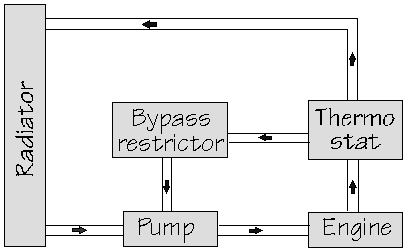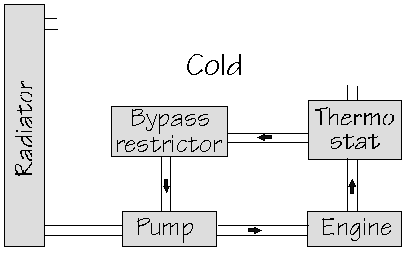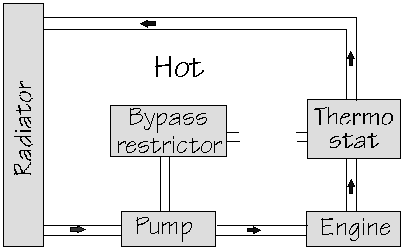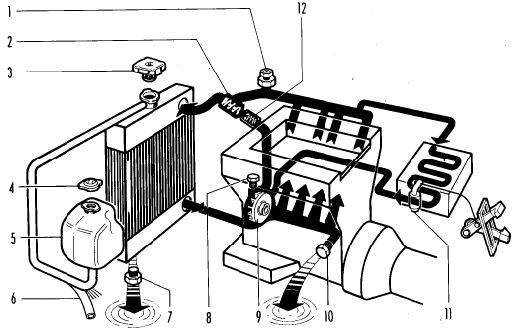
A couple of years ago, I got a ’80 Spider parts car that had a restrictor in its cooling system. Since my ’78 was missing its restrictor, I spent some time searching thru sources of information on how to install it and what it’s good for. Most of what I found was written by Fred Di Matteo, Charlie Thieriot, and Carter Hendricks. Here’s what I found.
The 1750 and 2000 cooling system looks something like this (heater circuit not shown):

Coolant flows out of the bottom of the radiator into the water pump and into the engine block. Coolant exits the head thru the intake manifold and then flows back thru the radiator, thru the bypass hose past the restrictor, or both, depending on temperature.
When coolant is cold, the thermostat blocks flow thru the radiator and allows flow only thru the bypass hose so the engine warms up faster:

When coolant is hot, the thermostat blocks flow thru the bypass hose and allows flow only to the radiator for maximum cooling:

At intermediate temperatures, the first diagram applies and water flows thru both the bypass hose and thru the radiator.
To function as it was designed, the proper thermostat must be installed. If your thermostat doesn’t have a disk at the bottom to close the bypass port, it can’t function as designed.

1 Air bleed valve on manifold 7 Radiator drain plug 2 Thermostat 8 Air bleed 3 Radiator cap, 10 PSI 9 Water pump 4 Reservoir filler cap 10 Drain plug on crankcase 5 Reservoir 11 Heater valve 6 Supply line from reservoir 12 Bypass control valve (restrictor) to radiator
Now, about the restrictor. Here’s what Fred Di Matteo said about it in an article in Velocissima from ca. ’91:
“The little known restrictor in the bypass hose has a spring loaded valve which allows more water to flow through the engine block and cylinder head when the thermostat is fully closed in all weather and when the water temp is below the operating range.”“The thermostat is shut tight until the water temperature increases to a point to begin letting the coolant flow through the radiator. As that happens, the back pressure on the bypass restrictor closes to allow more flow through the radiator. The function of the thermostat is to control the rate of coolant flow through the radiator so it doesn’t flow so fast it can’t be cooled enough in the radiator. People who mistakenly remove the thermostat succeed in making matters worse, not better.”
“Another function of the restrictor is not only to circulate water within the engine for quicker temperature rise, but it also gets hot water through the heater in the car on those cold, cold mornings. The restrictor must be installed in the bypass hose so the valve opens in the direction of flow. The small opening is not sufficiently large to pass all the water necessary when the engine is cold and the thermostat is closed.”
And, here’s what Carter Hendricks said about it in an article in i Saluti in ’91:
“The cooling system of the four cylinder cars remained unchanged in all of the four cylinder cars until the time of the release of the USA mechanical fuel injection cars for 1969. These cars introduced the water pump bypass. In the earlier cars water was picked up from the bottom of the radiator and directed through the cylinder head and out though the intake manifold. At this point the coolant met the thermostat, an automatic temperature regulation valve. At low temperatures the thermostat closes, keeping the coolant in the engine while heat is transferred from the bearings and combustion chamber. As the coolant around the thermostat chamber rises the valve begins to open. In pre-’69 cars the pump worked by simply pushing against the closed valve, wasting energy and allowing localized hot spots in the otherwise cool engine. The bypass allows a small proportion of coolant to avoid the thermostat during warmup, and the car heats to operating temperature quicker and more evenly.”“The two stage thermostat controls both the bypass hose and the main exit hose which pours the hot coolant into the top of the radiator. As the valve for the upper hose opens a lower extension plate closes the bypass. Without the small bypass restrictor, often discarded by shops and owners during hose replacement, the proper balance between the two systems is upset. Internal engine temperatures are less stable. Use of a cheap single plane thermostat does not close the bypass. If the restrictor is missing much of the coolant just circulates in and out of the engine block and the car overheats.”
As a clarification on the restrictor’s installation, it goes in the bypass hose spring side down, so the moveable disc faces the thermostat housing.